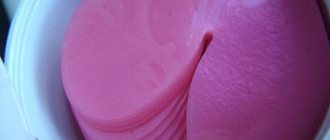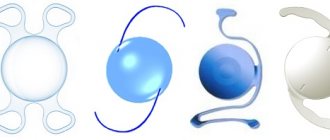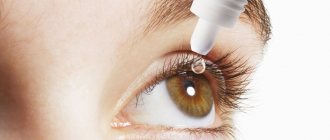Eye drops are medications for topical use that have a certain effect on the mucous membrane of the organs of vision. The prescription of drugs may be different:
- antibacterial;
- antiviral;
- vasoconstrictors;
- moisturizers and so on.
Before using any medication, you must read the instructions. The abstract always describes the algorithm for instilling drops into the eyes: scheme, dosage, frequency of use and duration of treatment. If you use an over-the-counter product on your own without visiting a doctor first, you must strictly follow the step-by-step instructions.
Why are drops placed in the eyes?
For children and adults, topical vision medications are prescribed for a variety of reasons. Most often they are eye diseases such as conjunctivitis, blepharitis, cataracts, glaucoma and the like. The use of medications is indicated before diagnostic or therapeutic procedures. Also, some products are used for daily care and maintenance of visual health. Medicines will be effective only if you follow the algorithm for putting drops into the eyes. Deviation from step-by-step instructions can lead to various complications. Let us consider in more detail how local treatment of the organs of vision should be carried out.
Features of the selection and use of eye drops for cataracts
The development of cataracts can be stopped with the help of drops, and the sooner the course of treatment is started, the higher its effectiveness will be.
But by and large, such remedies do not allow you to get rid of the disease completely, but only slow down the progression of cataracts.
And although the beginning of drug therapy at an early stage can lead to a significant slowdown in the development of pathological processes, it is possible to completely get rid of cataracts only through surgery. Despite this, the use of such drugs at first gives results.
Since these solutions contain substances that the lens lacks, as a result of which it becomes cloudy.
In addition, the drops help improve metabolic processes, resolve accumulations of protein compounds and restore tissues in which disorders are observed.
The effect of such drugs appears only with their constant use, which can last for years. If even short breaks in the course of treatment are allowed, the disease may progress again, as a result of which previous improvements are useless.
Hand hygiene
Before putting drops into the eyes of an infant, small child or adult, you must wash your hands thoroughly. If you miss the first point of the step-by-step instructions, then there is a possibility of introducing a new infection. As a result, the patient will not only not recover, but his health will only worsen.
Hand hygiene involves thorough washing using antibacterial soap. After this, wipe your palms dry and, if necessary, use sterile gloves. Additional protective equipment (gloves) are more often used in medical institutions. If you carry out the instillation procedure at home, then simply wash your hands.
Using eye drops
instructions for eye drops
- It is important to wash your hands thoroughly and remove contact lenses before using the drops. Many eye drops contain the drug in the form of a suspension, rather than in the form of a solution. These drops should always be shaken before use. Dacryocystitis most often occurs in children of the first year of life.
- The cap should be removed from the bottle, but never placed on a table in such a way that it becomes dirty. It should be held carefully in the other hand.
- During instillation, it is very important not to touch your eyes with the tip of the bottle. This can both damage the cornea and contaminate the remaining droplets. You can find a list of anti-inflammatory eye drops here.
- In the traditional method of instilling drops, the bottle is held upside down in one hand between the thumb and index finger. The head tilts back, you look up and, pointing the tip of the bottle closer to the lower eyelid, gently squeeze it to release one drop into the corner of the eye adjacent to the nose. Cheap analogues of duotrava can be found in our article.
- After instillation, you should close your eyes and place your index fingers on the inner corner of your eyes, pressing your nose for one or two minutes. This pinpoint pressure will reduce the amount of drug that reaches the nasopharynx and thus reduce any systemic absorption. What analogues of iridine exist can be found on our website.
- If you are giving more than one medicine to yourself, you should wait at least three minutes before giving the next medicine. As a general rule, you should wait at least 15 minutes before inserting contact lenses if you wear them.
Preparing the medicine
The technique of instilling drops into the eyes involves preparing a medicine. Many drugs must be stored in the refrigerator after opening. Applying a cold solution to the mucous membrane of the eye may seem uncomfortable. It is especially not recommended to conduct such experiments with children. If you store the drops in the refrigerator, then hold them in your palms for 10-15 minutes before using. Do not heat medicinal solutions.
If the container with the drug has a pipette, then it must be used individually. It is unacceptable to give medicine to other family members for treatment. If you need to use it by several people, you should stock up on individual pipettes. They must have a blunt end.
Common Mistakes
Despite the apparent simplicity of the procedure, many patients still make serious mistakes. It is unacceptable to prescribe the drug to yourself and use it. It is prohibited to use medications from your relatives or friends. Even if you have identical symptoms to them.
Do not change the dosage
. It is undesirable to skip medications, as this may affect the prognosis of treatment. If a medication was missed for some reason, the dose does not need to be doubled.
It is highly undesirable to neglect hand hygiene
or eyes before the procedure. There have been numerous cases of infection caused by dirty hands.
After instilling eye drops, do not immediately lower your head down
. The drug will leak out and no therapeutic effect will occur. Many mistakes are made by patients when storing medications.
Eye drops are made under sterile conditions, so most bottles have built-in droppers. But if drops need to be instilled using a pipette, then it must be clean
. The pipette should not lie on a dirty surface and should not be touched by the tip with your hands.
To properly store the drug, you need to carefully study the instructions.
. Some drops require refrigeration, others should not be exposed to direct sunlight.
If the medicine is stored in inappropriate conditions
, at best, the therapeutic effect will disappear. And in the worst case, the drug will turn into a dangerous substance.
Also, during storage, there is no need to tear off the labels and throw away the boxes. If the bottle is stored without a name, it can be confused with other drugs, which can lead to unpredictable consequences. In addition, the expiration date of the medicine is displayed on the label. If it is not visible, then you can drop expired medicine into the eye, which will also not lead to anything good.
During manipulation
The algorithm for instilling drops into the eyes involves alternately introducing the drug into each visual organ. To do this, you must follow the following instructions:
- take a sterile napkin and use it to pull down the lower eyelid;
- ask the patient to look up;
- with the other hand, insert the required amount of medicine, provided for in the instructions, into the conjunctival sac;
- ask the patient to close his eyes;
- blot any spilled water with a napkin or sterile cotton swab.
The algorithm for instilling drops into the eyes of a newborn is somewhat different. A small child will certainly resist during manipulation and will not want to look up at your guidance. To treat a newborn's eyes, follow these rules:
- place the baby on your left elbow, holding the baby’s arms with the same hand;
- take a pipette with medicine in your right hand;
- Use the ring finger of your right hand to slightly pull down the lower eyelid and inject the drug;
- The baby will involuntarily close his eyes, and at this time you can wipe away the remaining medicinal substance.
Detailed step-by-step instructions for use
Step 1. Before instilling the medicine, you need to disinfect your hands. First, wash them with soap (prefer antibacterial), then wipe dry with paper napkins. You should not use a towel for these purposes, because it may leave lint on your palms, which can cause irritation if it gets on the eyeball.
Step 2. Also, before instilling the drug, wipe your eyes. If you have contact lenses or glasses, remove them.
Be sure to read the instructions if you decide to instill the product yourself, and not as prescribed by an ophthalmologist. Read about side effects and contraindications (if any).
Step 3. Take a position that is comfortable for you - lie on the bed (without a pillow) or sit in a chair. It is not recommended to instill the medicine while standing. It will be great if you have a small mirror on hand.
Step 4. Remove the cap from the bottle.
Step 5: Tilt your head back.
Step 6. Next, pull down the lower eyelid with one finger to create a kind of “pocket” into which it is easier to drop the medicine.
Step 7. Take the bottle with your other hand, turn it over and bring the tip closer to the eyeball (but it should not touch the conjunctiva).
Step 8. Place one or two drops of the product, trying to do it as close to the outer corner as possible. If you drop more product than needed, it’s okay. This is explained by the fact that one drop on average contains 25 μl, while about 15 μl is retained in the eye of an adult. The excess will be removed along with tears.
Step 9. Once you have managed to instill the drops, close your eyes for a few minutes to distribute the drug evenly. It is not recommended to blink (so as not to wash the solution), but you can massage the corners with light movements.
Step 10. Take a clean handkerchief and wipe off any excess from your eyelids. The second eyeball needs to be instilled in exactly the same way.
Step 11. If you have been prescribed several eye drops at once, you need to drip them at different times, not at the same time. Maintain the required interval between instillations from 5 to 20 minutes; the exact time depends on the specific drug. This way the components will not react with each other.
As for contact lenses, they can be put on at least twenty minutes after the drug is instilled. Otherwise there is a risk that it will react with them and damage them.
Watch a video on how to apply eye drops:
After the procedure
Having learned how to properly instill drops into your eyes, you will be able to carry out daily manipulation without the involvement of medical professionals. After the procedure, wash your hands again and disinfect the pipettes, if possible. Repeat the manipulation as many times a day as recommended by your doctor or instructions. Do not exceed the prescribed dosage.
Some medications require compliance with certain rules after applying the drops:
- refusal to drive a vehicle (since the medicine reduces visual acuity, such drugs are usually used before diagnostic procedures);
- restrictions on the use of contact lenses (for a few minutes after application or the entire course of treatment);
- additional use of ointments or topical eye medications.
In what cases do you need eye drops?
The term “eye drops” refers to a range of liquid preparations for external use intended for the prevention/treatment of ophthalmic diseases. Sometimes these drugs are even more effective than traditional pills. The dosage is calculated in such a way that part of the product gets into the blood, part - onto the mucous membrane, and the rest simply spills out, which is inevitable. Therefore, it is important to apply eye drops not only correctly, but also to do it at approximately the same time.
Retracting the eyelid for instillation
This is especially important for people who are at the stage of postoperative recovery, suffering from acute pathologies and glaucoma.
As a rule, doctors prescribe eye drops in the following cases:
- infectious eye diseases. Medicines actively fight various types of viruses and bacteria. The most common pathologies of this nature include blepharitis, barley and conjunctivitis;
- development of the inflammatory process in the eye area. According to statistics, inflammation most often occurs against the background of diseases such as iridocyclitis, chorsoiditis or iritis;
- manifestation of allergic reactions. Doctors may prescribe eye drops to be applied to the eyes to combat the signs of allergies, both during their exacerbation and for preventive purposes;
- with the development of ophthalmological diseases such as cataracts and glaucoma. If you instill eye drops, this helps normalize intraocular pressure;
- the occurrence of pain syndrome. Thanks to anesthetic solutions prescribed by doctors, it is possible to relieve painful symptoms during the development of various pathologies. They are also instilled after eye surgery;
- preparing the patient for a diagnostic examination. Before a laboratory eye examination, a medication may be prescribed to dilate the pupils. This makes it possible to increase the efficiency of assessing the extent of damage;
- to prevent dry eyes. There are separate medications available in the form of eye drops called artificial tears. As a rule, they need to be instilled more than once during the adaptation period when wearing contact lenses or to prevent dry eyes during prolonged work at the computer.
Contraindications to eye drops for cataracts
contraindication Source: antifa-action.org.ua
The use of any eye drops for cataracts, regardless of their name, is contraindicated if you are allergic to their components, as well as in childhood.
In addition, each of the drugs may have its own specific contraindications, which are described in detail in the instructions for use, which must be carefully read before using them.
Since the effectiveness of conservative treatment of cataracts has not been proven by scientific medicine, there is not enough experience with its use during pregnancy. Therefore, it is better for pregnant and breastfeeding women to refrain from using eye drops for cataracts.
Like any medicine, all eye drops used to treat cataracts have side effects. Since these drugs contain different active ingredients, side effects may be different; you can read them in more detail in the instructions for each product.
Most often, these reactions are local in nature and pass quickly. However, if they develop, you should stop using the drug, and you should also consult an ophthalmologist.
Each type of cataract drops has its own dosage:
- Quinax – 1-2 drops 3-5 times a day.
- Vita-Iodurol – 1-2 drops 2-3 times a day.
- Nevanak – 1 drop 3 times a day.
- Oftan Katahrom – 1-2 drops 3 times a day.
- Taurine-Acos – 1-2 drops 2-4 times a day.
- Taufon - 1-2 drops 2-4 times a day.
Preparatory stage
Before instillation, you must carefully prepare. There are several recommendations that will help you avoid making mistakes:
- Check the drops. They must be of the correct expiration date and have a dispenser.
- Wash your hands thoroughly with soap; do not use alcohol here, as it may accidentally get into the child's eyes, causing discomfort.
- It is better to rinse the pipette or bottle in hot water to avoid infection.
- If the drops are stored in the refrigerator, it is better to warm them to room temperature. To do this, just take the bottle in your hand.
- The dropper can only be used in the eyes or ears. One should not be used in two cases.











